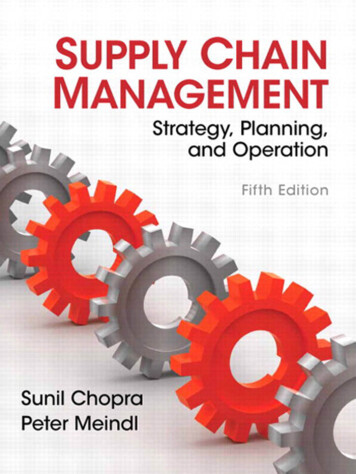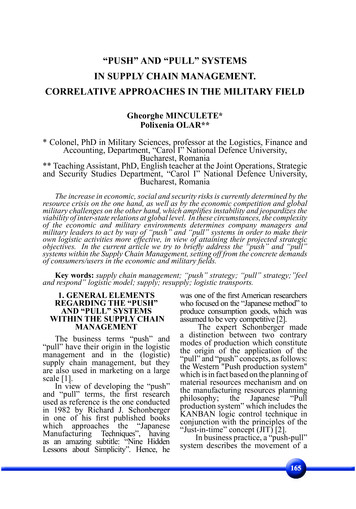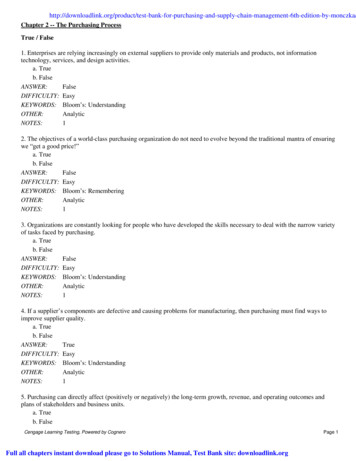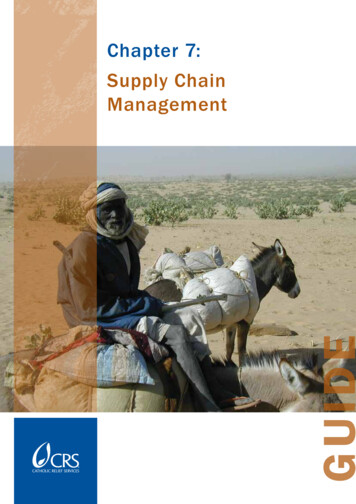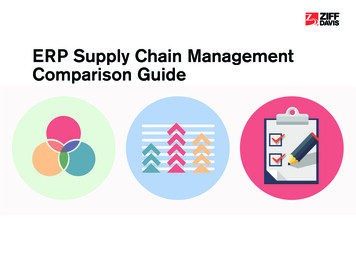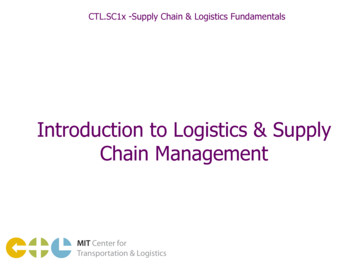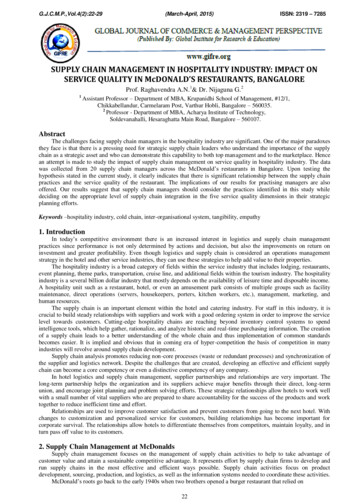
Transcription
G.J.C.M.P.,Vol.4(2):22-29(March-April, 2015)ISSN: 2319 – 7285SUPPLY CHAIN MANAGEMENT IN HOSPITALITY INDUSTRY: IMPACT ONSERVICE QUALITY IN McDONALD’S RESTAURANTS, BANGALOREProf. Raghavendra A.N.1& Dr. Nijaguna G.21Assistant Professor – Department of MBA, Krupanidhi School of Management, #12/1,Chikkabellandur, Carmelaram Post, Varthur Hobli, Bangalore – 560035.2Professor - Department of MBA, Acharya Institute of Technology,Soldevanahalli, Hesaraghatta Main Road, Bangalore – 560107.AbstractThe challenges facing supply chain managers in the hospitality industry are significant. One of the major paradoxesthey face is that there is a pressing need for strategic supply chain leaders who understand the importance of the supplychain as a strategic asset and who can demonstrate this capability to both top management and to the marketplace. Hencean attempt is made to study the impact of supply chain management on service quality in hospitality industry. The datawas collected from 20 supply chain managers across the McDonald’s restaurants in Bangalore. Upon testing thehypothesis stated in the current study, it clearly indicates that there is significant relationship between the supply chainpractices and the service quality of the restaurant. The implications of our results for practising managers are alsooffered. Our results suggest that supply chain managers should consider the practices identified in this study whiledeciding on the appropriate level of supply chain integration in the five service quality dimensions in their strategicplanning efforts.Keywords –hospitality industry, cold chain, inter-organisational system, tangibility, empathy1. IntroductionIn today’s competitive environment there is an increased interest in logistics and supply chain managementpractices since performance is not only determined by actions and decision, but also the improvements on return oninvestment and greater profitability. Even though logistics and supply chain is considered an operations managementstrategy in the hotel and other service industries, they can use these strategies to help add value to their properties.The hospitality industry is a broad category of fields within the service industry that includes lodging, restaurants,event planning, theme parks, transportation, cruise line, and additional fields within the tourism industry. The hospitalityindustry is a several billion dollar industry that mostly depends on the availability of leisure time and disposable income.A hospitality unit such as a restaurant, hotel, or even an amusement park consists of multiple groups such as facilitymaintenance, direct operations (servers, housekeepers, porters, kitchen workers, etc.), management, marketing, andhuman resources.The supply chain is an important element within the hotel and catering industry. For staff in this industry, it iscrucial to build steady relationships with suppliers and work with a good ordering system in order to improve the servicelevel towards customers. Cutting-edge hospitality chains are reaching beyond inventory control systems to spendintelligence tools, which help gather, rationalize, and analyze historic and real-time purchasing information. The creationof a supply chain leads to a better understanding of the whole chain and thus implementation of common standardsbecomes easier. It is implied and obvious that in coming era of hyper-competition the basis of competition in manyindustries will revolve around supply chain development.Supply chain analysis promotes reducing non-core processes (waste or redundant processes) and synchronization ofthe supplier and logistics network. Despite the challenges that are created, developing an effective and efficient supplychain can become a core competency or even a distinctive competency of any company.In hotel logistics and supply chain management, supplier partnerships and relationships are very important. Thelong-term partnership helps the organization and its suppliers achieve major benefits through their direct, long-termunion, and encourage joint planning and problem solving efforts. These strategic relationships allow hotels to work wellwith a small number of vital suppliers who are prepared to share accountability for the success of the products and worktogether to reduce inefficient time and effort.Relationships are used to improve customer satisfaction and prevent customers from going to the next hotel. Withchanges to customization and personalized service for customers, building relationships has become important forcorporate survival. The relationships allow hotels to differentiate themselves from competitors, maintain loyalty, and inturn pass off value to its customers.2. Supply Chain Management at McDonaldsSupply chain management focuses on the management of supply chain activities to help to take advantage ofcustomer value and attain a sustainable competitive advantage. It represents effort by supply chain firms to develop andrun supply chains in the most effective and efficient ways possible. Supply chain activities focus on productdevelopment, sourcing, production, and logistics, as well as the information systems needed to coordinate these activities.McDonald’s roots go back to the early 1940s when two brothers opened a burger restaurant that relied on22
G.J.C.M.P.,Vol.4(2):22-29(March-April, 2015)ISSN: 2319 – 7285standardized preparation to maintain quality the Speedy Service System. So impressed was Ray Kroc with the brothersapproach that he became their national franchise agent, relying on the company’s proven operating system to maintainquality and consistency. McDonald’s entry in India dates back to 1993 where in it incorporated its wholly ownedSubsidiary McDonalds India Private Ltd.A unique sense of dedication and commitment characterizes McDonald's India - a commitment to be driven by theleadership of local owners. Commitment to provide quality products and fast friendly service at a real value to supportother Indian businesses through local sourcing and imparting new skills and to generate local employment by being a partof the local culture. This commitment has translated into enduring benefits to the businesses at the grass root level, in theareas of introduction of new crops, new agricultural practices and food processing methods and procedures. McDonald'sunique 'cold chain', on which the Quality Service Regime has spent more than six years setting up in India, has broughtabout a veritable revolution, immensely benefiting the farmers at one end and enabling customers at retail counters to getthe highest quality food products, absolutely fresh and at great value. McDonald's, through its unique cold chain, hasbeen able to, both cut down on its operational wastage, as well as maintain the freshness and nutritional value of raw andprocessed food products. This has involved procurement, warehousing, transportation and retailing of perishable foodproducts, all under controlled temperatures.A McDonald's burger is not just a burger but an outcome of dedicated efforts by farmers, its suppliers, distributioncentre and a firm promise by McDonald's. McDonald's contributes a great back end process which enables you to enjoyyour favourite burger fresh & hot, and for that, the supply chain truly acts as a backbone of the business.The supply chain begins at the grass root level, with the suppliers receiving the crop from the farmers. The crop isthen processed and dispatched to the Distribution centres in special temperature controlled trucks, which ensures that thequality of the items is not compromised. These items are stored in rooms with different temperature zones and are finallydispatched to the McDonald's restaurants on the basis of their requirements. McDonald's expectation of 'Cold, Clean, andOn-Time Delivery' plays a very vital role in maintaining the integrity of the products throughout the entire 'cold chain'.The McDonald’s supply chain is a complex web of direct and indirect suppliers. They manage this complex systemby working with direct suppliers who share the company values and vision for sustainable supply. The company holdsthem to clear standards of quality, safety, efficiency and sustainability. It expects them to extend those requirements totheir suppliers.3. Statement of the ProblemHistorically, the procurement function was viewed as low level, back office operation that existed solely to beat upsuppliers for lower prices. “Three bids and a cloud of dust” is an expression used by many veteran procurementprofessionals to describe this traditional approach to supplier relations. The traditional approach to suppliers was pricebased, surface level, short term and extremely short-sighted. Today, innovative supply managers realize that, once theyhave selected the best suppliers, mutual cooperation can pay big dividends for both customer and supplier. While allcompanies want to pay the lowest possible purchase price for goods and services, leading companies have realized thatpurchase price is only one element of total cost, and that it’s critically important to establish continuous improvementprograms with strategic suppliers.Technology has further differentiated small hospitality companies that struggle to manage their supply chains withlimited resources and budget from large, multi-unit chains that can afford to invest in solutions to gain visibility andcontrol. Many multi-unit chains have begun taking charge of the procurement process, using technology to managesourcing back to raw materials suppliers and even buying futures on the commodity market. Myriad business modelvariations exist among hotels, restaurants, resorts, casinos, and cruise ships. As a result, sourcing operations canencompass a few hundred or thousands of Stock Keeping Units. Purchasing in the hospitality industry is furthercomplicated by the fact that many businesses face fragmented management operations—which can include franchiseesand individual owner/operators—as well as managing multiple brands under one corporate umbrella.Common industry sourcing and procurement challenges include maverick local buying, and a lack of centralizedprocesses to ensure that purchases and deliveries meet contracted pricing, brand, and quality standards. Proprietarydistributor ordering systems and non-standardized product descriptions also lead to waste. It is not uncommon, forinstance, for a chain to learn it purchases the same size ketchup bottles under multiple product descriptions. That lack ofcontrol, coupled with the volume of product that hospitality companies manage, causes them to lose money that shouldgo to the bottom line. Companies lose money when they fail to take a proactive approach to procurement. Hence aresearch is undertaken to understand the impact of supply chain management on service delivery in hospitality industrywith specific reference to McDonalds, Bangalore.4. Literature ReviewWong et al., (2004): According to them, “A supply chain (SC) is a wide (national/global) network of suppliers,manufactures, warehouses, distribution centres and retailers through which raw materials are acquired, transformed anddelivered to customers”. Supply chain management (SCM) deals with the coordination of manufacturing and logisticsactivities between autonomous decision making units. They further state that optimizing supply chain activities is criticalto all industries since it saves money, increases throughput, decreases inventory levels and increases revenues, therebyimproving the organization’s financial status. Thus, integration of various business processes is an integral part ofbuilding supply chain initiative.Aitken et al. (2005): They express that there may be a range of different supply chain solutions for differentcustomers and vigilant analysis is required to determine the design that is appropriate to a particular business strategy.Supply chain management is beyond just buying and selling; it helps a firm to maintain the competitive advantage overother companies. The strategic focus of supply chain management is still evolving and is a major challenge for managersand researchers.23
G.J.C.M.P.,Vol.4(2):22-29(March-April, 2015)ISSN: 2319 – 7285S.A.Melnyk et al. (2009): In their opinion, supply chain management has gained momentum and is the order ofdoing business successfully in both domestic and international assignments. The supply chain system design is dynamicand changes from firm to firm and country to country. Further they noted that supply chain management lacks talentmanagement due to insufficient supply of skilled, cross-functional trained supply chain experts. Models focusing oncompetencies required to perform various roles of supply chain need to be developed. Specifically global businessproficiency need to be developed as trade scenario these days is dispersed across multiple countries. Training in the areasof strategic and operational levels of supply chain is needed. There is lack of industry-academic interface which needs tobe strengthened. To become supply chain leaders, employee advancement through supply chain competencies, gainingcross-functional expertise is considered to be need of the hour.Tan et al. (2002): They indicate that the important element of supply chain integration is inter-organisationaldecision making in collaboration with supply chain members and their involvement in the strategic decision making ofthe supply chain entities. Increasing global cooperation, vertical disintegration and a focus on core competencies have ledto the concept that firms are linked in a networked supply chain. A truly integrated supply chain network requirescommitment by all the members of chain. Buyers have to revamp their purchasing cycle to integrate externally withsupplier’s engineering teams and internally with product designers. Thus, they point out the need for involving all supplychain members in the business processes of the firm.Meixell, M.J. and Gargeya, V.B. (2005): th
The McDonald’s supply chain is a complex web of direct and indirect suppliers. They manage this complex system They manage this complex system by working with direct Author: A N Raghavendra, G NijagunaPublish Year: 2015


